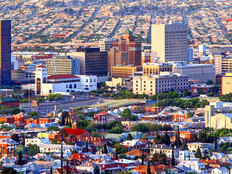Courting Video Conferencing
Conducting routine hearings from afar rather than transporting prisoners saves states and counties money.
Across Louisiana, video conferencing systems proved their worth for handling routine court hearings after Hurricane Katrina hit. Now, they're demonstrating staying power because of the significant savings they provide compared with transporting prisoners to and from court.
"Prior to Katrina, all arraignments were done with prisoners driven by van into court and with all the associated costs, including people to drive the vans, insurance on the vehicles and fuel,'' says Jerry Bourgeois, MIS administrator for Louisiana's 24th Judicial District Court in Gretna, a suburb of New Orleans.
In advance of Hurricane Katrina, more than 1,000 prisoners from the Gretna jail were evacuated and sent to other prisons across the state, where they were held for several months. Luckily, the 24th Judicial District Court had three Polycom mobile video conferencing systems that it was testing for digital evidence presentation. The court used these systems to conduct remote arraignments until the jail re-opened.
"We found it was a very cost-effective and efficient way to do arraignments," Bourgeois says. "We started doing this on an emergency basis, but now we're doing it on a convenience basis."
A growing number of courts are turning to video conferencing as a way of reducing the costs associated with transporting prisoners to arraignments, post-conviction motions and parole board hearings. The practice is catching on because today's video conferencing systems cost only a few thousand dollars, provide high-quality images and use the Internet rather than dedicated networks.
Take It to Telecourt
Ten years ago, state courts began using video conferencing systems, and today the practice is widespread, says Greg Hurley, an analyst with the National Center for State Courts.
"The case type that video conferencing is used primarily for at the moment is arraignments. It's a relatively simple usage of the technology," Hurley says, adding that all arraignments of people in custody in West Virginia are conducted via video conferencing. Parole board hearings are also fairly common, but he doesn't see much use of video conferencing for general expert testimony yet.
Hurley says telecourt applications are expanding because they eliminate the cost and hassle of transporting prisoners to routine hearings. Video conferencing also improves the community's safety because prisoners aren't being driven around the state to attend hearings.
The 24th Judicial District Court in Gretna handles up to 20 arraignments per month using its three mobile Polycom VSX 7000s systems. Upgraded three years ago, these $6,000 units have worked so well that the 24th Judicial District Court plans to install video conferencing cameras in all of its 16 courtrooms, says Bourgeois.
"We just installed a $1.1 million high-tech evidence presentation system," he says. "We left the ability for that to be connected to video conferencing systems."

Louisiana's 24th Judicial District Court handles up to 20 arraignments per month using video conferencing gear, says MIS Administrator Jerry Bourgeois.
Photo Credit: Rick Olivier
Bourgeois says the biggest benefit of the video conferencing systems is reducing the need for security personnel to accompany prisoners from the jail to the court for arraignments.
"We're also getting them arraigned quicker so they can get out of jail or be brought to trial quicker," Bourgeois says. "The whole process was sped up. ... Video conferencing overall allows the court to handle more cases in a given year."
An Appealing Solution
In Louisiana, the Department of Public Safety and Corrections has been using video conferencing systems to bring prisoners into parole board and pardon board hearings. In 2009, the state installed 15 Polycom video conferencing systems in its busiest court districts so it doesn't have to transport prisoners to post-conviction hearings such as motions for appeal, which can take anywhere from 5 to 20 minutes in court.
Louisiana purchased mobile Polycom QDX 6000s for about $4,000 each for six courts, with multiple units in some of its largest courts, such as that in New Orleans. These new units link to existing Polycom units at the Louisiana State Penitentiary, a maximum-security prison with more than 5,000 inmates located in Angola.
Arraignments, sentencing, search warrants, judicial release and pretrial conferences accounted for 70.6% of video conferencing use by Cuyahoga County, Ohio, according to a 2009 report from the National Center for State Courts.
"In the past, the inmates would have to be escorted to a remote court location by two officers. If it was a death row case, we'd have to send five officers," explains Karl Prince, IT technical support supervisor at the penitentiary. "By using video conferencing, you're looking at cost savings for the employee salaries by not needing those officers. And you have the mileage costs and the wear and tear on the vehicles."
Prince estimates that it costs between $400 and $500 for a prisoner to be driven from Angola to the New Orleans court, up to three hours away. Last year, the prison averaged 30 trips per month to New Orleans, which means the three Polycom units that were installed at the New Orleans court paid for themselves during their first month of operation.
"You also get a lot of intangible benefits in terms of public safety," Prince says. "We don't have this inmate out on the streets, and the chance of him escaping ... is taken completely out of the picture."
Prince sees no drawbacks to the Polycom systems, which handled 40 post-conviction hearings in October. "We've been able to use the existing Internet connections that the courts have, and they've had enough bandwidth available," he says. "The video and audio are almost flawless."
Keeping Up Appearances
The Hall County Magistrate Court in Gainesville, Ga., is reaping the same benefits with the LifeSize video conferencing units purchased for its new courthouse two years ago. There are 10 LifeSize units installed in the courthouse, jail and the public defender's office. These video conferencing systems handle all initial court appearances.
"We do video conferencing six days a week, and we average 20 to 30 first appearances per day," says Josh Thompson, court information systems manager with the Northeastern Judicial Circuit. "The biggest benefit is the security and peace of mind for our judges. They don't have to be in the same room as the inmates."
Hall County spent around $125,000 on the LifeSize systems, which include a high-end LifeSize Room system in the courthouse and smaller LifeSize Team systems in the six dedicated video conferencing rooms in the jail. The jail systems are ruggedized and mounted to prevent the inmates from breaking them or accessing cables.
"We have a touch-panel system, so the judges can sit down in front of the LifeSize Room system and select which rooms in the jail they want to connect to," Thompson says. "The reason we picked LifeSize is because of the multipoint connections and the integration of the touch-panel, which is easy to use for our judges."
Video conferencing systems for arraignments and other initial court appearances has become the standard way of doing business for judges, attorneys and prisoners in Hall County. "It's one of those technologies where once you get into it and you get used to it, you wonder how you got along without it," Thompson sums up.
Aid for Domestic Violence Victims
Maryland's Montgomery County Family Justice Center is one of the first facilities in the United States to use video conferencing technology to host protective-order hearings for victims of domestic violence.
The Maryland Judiciary has launched a pilot project to link the new Family Justice Center, which opened in April, to the Montgomery County circuit and district courts via live video links. Victims of domestic violence will use video conferencing systems to get temporary protective orders from the courts without having to leave the safety of the center.
In 2008, Montgomery County courts granted more than 1,850 temporary protective orders to victims of domestic violence, including stalking, assault and rape. Victims often wait four or five hours in court, some with children in tow, before receiving a temporary protective order.
The goal of the video conferencing systems is to provide better service to the victim, says Jo Ann Ricchiuti, administrative services coordinator for the Montgomery County Sheriff's Office. "This is better than having them sitting in court all day and having their children sitting in court all day," she says. "Here, they can receive other services while they are waiting to appear on the court docket."
At the Family Justice Center, victims can go to one location to access police, prosecutors and representatives of nonprofit organizations. The center offers babysitting, so victims don't have to worry about their children while they fill out the necessary paperwork and are interviewed by the judge.
Officials at the Family Justice Center plan to buy 16 video conferencing systems: four for the center and six each for the district and circuit courts. The systems will be installed early this year.
"The problem of domestic violence is huge," says Ricchiuti. "If you make the services more convenient, then more people will take advantage of them."







